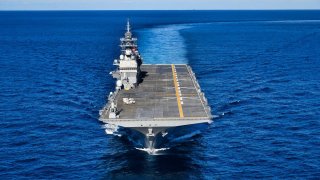Japan: The Next Aircraft Carrier Superpower?
Despite maintaining a non-offensive stance, the upgrade of the JS Kaga, alongside the JS Izumo, into aircraft carrier-like ships underscores Japan's evolving defense strategy in the face of current geopolitical challenges, ensuring it remains a formidable force in maritime self-defense and collective security efforts.
Summary: Seventy-nine years after the sinking of the Imperial Japanese Navy's aircraft carrier Amagi, marking the end of Japan's World War II naval ambitions, Japan has unveiled the upgraded JS Kaga at Kure—the same port where Amagi met her demise. This modern vessel, initially a "multi-purpose operation destroyer," has been transformed into a de facto aircraft carrier capable of hosting the F-35B Lightning II. The transformation symbolizes a significant shift in Japan's defense capabilities and posture, reflecting changes in regional security dynamics and the reinterpretation of its pacifist constitution. Despite maintaining a non-offensive stance, the upgrade of the JS Kaga, alongside the JS Izumo, into aircraft carrier-like ships underscores Japan's evolving defense strategy in the face of current geopolitical challenges, ensuring it remains a formidable force in maritime self-defense and collective security efforts.
Japan's Secret Aircraft Carriers
It will be 79 years ago this July 29 that the Imperial Japanese Navy's Unry -class aircraft carrier Amagi was sunk in port at Kure. She capsized and sank after taking numerous hits during an American air raid just days before the atomic bomb was dropped on Hiroshima.
Amagi has the distinction of being the final carrier ever to be sunk by an enemy. Three other carriers – Hosho, Junyo, and Katsuragi – survived the war, and the latter vessel was used to return Japanese soldiers from various island bases. However, the sun had set on the IJN and with it any Japanese aircraft carrier ambitions.
The post-World War II Japanese constitution renounced war as the sovereign right of the nation, and armed forces with war potential would not be maintained. That constitution is also notable in that it hasn't been amended since its implementation in 1947.
Yet, this week in the same port were Amagi was sunk, Japan unveiled its recently upgraded warship JS Kaga, which was recently modified to host the Lockheed Martin F-35B Lightning II. The Short/Vertical Takeoff and Landing (S/VTOL) variant of the Joint Strike Fighter was developed to operate from the U.S. Navy's amphibious assault ships and similar vessels.
A New Japanese Carrier
The Japan Maritime Self-Defense Force (JMSDF) has operated the JS Kaga (DDH-184) as a multi-role helicopter carrier since 2015. Throughout her service to date, she has been officially described by Tokyo as a "multi-purpose operation destroyer" as her main purpose was to seek out and destroy enemy submarines in the self-defense of Japan.
The role of the Izumo-class vessel is evolving.
The JMSDF showed off the Kaga to the press on Monday at its Kure Base in Kure, Hiroshima Prefecture, after first-stage modification work to make it capable of accommodating fixed-wing fighter jets was completed. Those modifications have transformed the helicopter carrier, allowing it operate as a de facto aircraft carrier.
The major change has been in the shape of its flight deck, which is now completely rectangular, enabling fighter jets –notably the F-35B – to take off safely. With the external modifications completed, she closely resembles the U.S. Navy's America-class amphibious assault ships. The flattop will receive second-stage modifications beginning in fiscal 2026 when facilities inside the ship's body will be altered.
"The first special modification work on the destroyer 'KAGA' was completed as planned on March 29. The JMSDF will continue to systematically carry out the necessary modifications to the 'IZUMO' class destroyer in order to acquire the operational capability of the F-35B," the JMSDF (@jmsdf_pao_eng) announced via a post on X, the social media platform formerly known as Twitter.
A Two Aircraft Carrier Fleet
The Kaga is the also the first vessel in the JMSDF fleet to have its flight deck redesigned into a rectangular shape. The JS Izumo has already undergone its initial modification stage, with the work primarily entailing the application of heat-resistant paint to its flight deck.
Following the conversion of both Izumo-class warships, Japan is poised to have two vessels to support its incoming fleet of 42 F-35B jets. Both the Izumo and the Kaga have an overall length of 248 meters, making them the largest surface combat ships of the JMSDF.
Aircraft Carriers Except in Name
Despite these modifications of the vessels, Tokyo remains cautious in its exact terminology, refraining from explicitly labeling the modified Izumo-class vessels as aircraft carriers. That decision aligns with the nation's long-standing defensive security policies under its pacifist constitution.
Moreover, while the Japanese constitution hasn't been modified, in 2014, then-Prime Minister Shinzo Abe approved a reinterpretation of Article 9. That reinterpretation allows Japan to exercise the right of "collective self-defense," in some instances, and even to engage in military action if one of its allies were to be attacked.
Regardless of what it is called, Japan is once again operating carriers – and if necessary in wartime, they could be supporting America's flattops
Author Experience and Expertise: Peter Suciu
Peter Suciu is a Michigan-based writer. He has contributed to more than four dozen magazines, newspapers, and websites with over 3,200 published pieces over a twenty-year career in journalism. He regularly writes about military hardware, firearms history, cybersecurity, politics, and international affairs. Peter is also a Contributing Writer for Forbes and Clearance Jobs. You can follow him on Twitter: @PeterSuciu.
You can email the author: [email protected].
Image Credit: Japan Maritime Self Defense Force/X.


